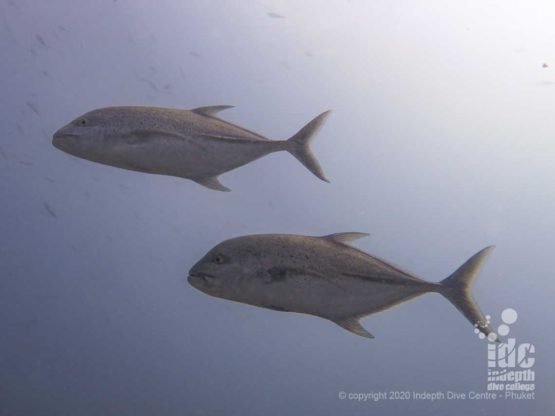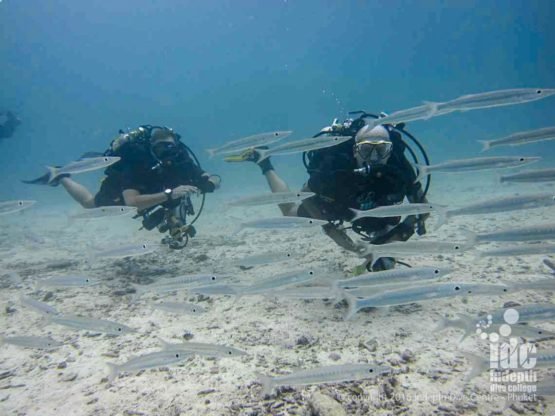Similans Diving: Breakfast Bend / Three Trees
Breakfast Bend on Similans Island 9 is best entered in the middle of the middle of the dive site. If you do this, then you would be performing a free descent into water between 5-10m.Breakfast Bend has pretty much every type of coral you can find in the Similans. As such this includes Staghorn Coral, Finger Coral, Brain Coral, Pore Coral, Sea Whips and Anemones. To start with we would suggest you head East where you will reach the sand line at around 20m. There is a large sandy area where there are lots Garden Eels. Also in the deeper water, around 25m you will see Spaghetti Eels, Khuls and Blue Spotted Stingrays. And there is also a chance to see the larger Stingrays such as Porcupine Rays and Jenkins Rays. Scattered throughout the dive site in the deeper waters between 20-35m, are some very beautiful coral bomies. And it is here you will find some very large Gorgonian Sea Fans with very colourful soft corals. Look in the Sea Fans for Long Nosed Hawkfish. Also on these coral bommies you can usually spot the solitary Juvenile Emperor Angelfish. This is along with Banded Boxer Shrimps, Cleaner shrimps and the elusive, but very beautiful, Comet Longfin.
Similans Drift Diving
The Breakfast Bend Similans dive site is almost always a Drift Dive, as are many Similan dives due to the currents. So, if you are not used to scuba diving in currents then this is a prefect dive site to take your PADI Drift Adventure Dive. Thus if you find you like Drift diving, then you are in the perfect place to take your PADI Drift Diver Specialty Course. The skills learnt on the Drift Diver course are going help you tremendously on your Similan Islands Liveaboard Safari. From here keep moving across the sand and you will see some big groupers. In fact the Groupers seem to just get bigger and bigger. Additionally, you have a good chance for some of the bigger things. so keep your eyes peeled for Leopard Sharks and White Tip Reef Sharks. And if you’re really lucky, then you may just get to see rare Shovelnose Rays, commonly misnamed Guitar Sharks. These 3m long very strange looking creatures seen from time to time. We typically see them in the deeper areas on the sand near or behind the boulders.
Beware of “The Minefield”!
As such there have the chance to spend maybe half an hour here. Use you time wisely and go looking for sharks.Just wait for the open circuit divers to leave, which won’t be long at this depth, and take your time and see what sharks are around. You can often come across them on the sand. If you move slowly are carefully, you can get very close to them. This is an excellent photo opportunity.Accordingly, for open circuit divers, as you run short of dive time / no decompression time, head back to the reef. But beware of “The Minefield”!
These can get somewhat aggressive during nesting time, especially the larger females. Hence you need to just be careful to keep some distance between you and their nest. If you do this then they will generally leave you alone. But, if the ‘trigger’ or fin on the top of their head goes up, it’s a different story. In this case be ready to dodge and swim away horizontally / backwards, rather than upwards.
After exploring the sandy areas and deeper coral bombies it’s time to head back to the reef. Once you get there then what you do next will depend on the current. Thus, if the current is zero, then head North. Generally speaking the coral / sand line is around 20m heading in this direction. By the same token if you head South the coral line is a little deeper between 25-30m.
Breakfast Bend Marine Life
There is a very large school of Chevron Barracudas on this site numbering over 200. In the mid-water are some very large Tuna. Along with large schools of Fusiliers and the ever friendly Batfish. Napoleon Wrasse are often seen in the mid water or in the shallows at any depth. On the Breakfast Bend reef itself you will find the usual Andaman Sea marine life. This means Puffer Fish, Porcupine fish, Trigger Fish (including the Clown Trigger) and Angel Fish. Also Butterfly Fish, Box Fish, Surgeon Fish and Unicorn Fish. You will also find Turtles, Trumpet Fish, Wrasse, Groupers and Parrot Fish. And without being too boring also Sweetlips, Hawkfish, Octopus and Sea Snakes and so on.
From the reef you can then head back up to the shallow hard coral reef and continue along. Here you should be looking Turtles as you make your way up towards your safety stop.
When you finish your safety stop, head out off the reef before you ascend. This is to take a quick look for the resident school of Barracuda and if you get lucky maybe even a Manta fly-by ...













